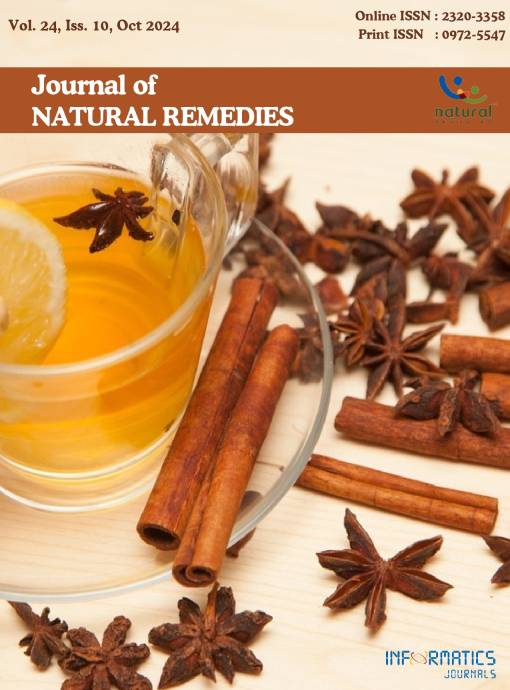Exploring the Anti-Diabetic Potential of Cichorium intybus through Integrated Network Pharmacology Analysis and Molecular Docking Validation
DOI:
https://doi.org/10.18311/jnr/2024/44047Keywords:
Antidiabetic, Cichorium intybus, Molecular Docking, Network Pharmacology, Type 2 DiabetesAbstract
Background: The major global health concern known as Type 2 Diabetes Mellitus (T2DM) ischaracterized by increased blood sugar level and insulin resistance. It is a common and complicated metabolic illness that needs to be understood from many angles in order to be predicted and treated effectively. Aim: Therefore, in his study, we aim to reveal the accurate and in-depth roots to predict the progression of diabetes and its management. Methods: A workable compound-target-pathway network pharmacology model and molecular docking studies were created by combining compound screening and target prediction. This model enabled researchers to systematically anticipate potential compounds and the mechanisms of Cichorium intybus anti-diabetic actions. Results: The results of the network pharmacology study were subsequently verified by using molecular docking, which effectively identified several active compounds of C. intybus and several targets that support anti-diabetes. For analytical purposes, four primary active chemicals are considered here: myricetin, cyanidin, quercitrin, and chicoric acid. These compounds act on targets such as alpha-amylase (1B2Y) and alpha-glucosidase (3W37). Here network pharmacology is used to build an interactive, complete network of genes relevant to diabetes, proteins, and pathways then validation is done through docking. Docking score of all 5 active compounds for both the targets alpha-glucosidase (PDB:3W37) and alpha-amylase (PDB:1B2Y) are considered. So, compound quercetin and cyanidin with both targets show the strongest binding affinities and interactions. Conclusion: Thus, this research successfully concludes the prediction of the active chemicals and targets of C. intybus for the treatment of diabetes. It offers fresh perspectives on the pharmacological and molecular foundations of C. intybus.
Downloads
Metrics
Downloads
Published
How to Cite
Issue
Section
Categories
License
Copyright (c) 2024 Ayesha Hena Afzal, Ozair Alam, Sherin Zafar, Afshar Alam, Jalaluddin Khan (Author)

This work is licensed under a Creative Commons Attribution 4.0 International License.
Accepted 2024-08-31
Published 2024-11-06
References
Aisa HA, Xin X, Tang D. Chemical constituents and their pharmacological activities of plants from Cichorium genus. Chinese Herb Med. 2020; 12(3):224-36. https://doi.org/10.1016/j.chmed.2020.05.001
Saeedi P et al. Global and regional diabetes prevalence estimates for 2019 and projections for 2030 and 2045: Results from the international diabetes federation diabetes atlas, 9th edition. Diabetes Res Clin Pract. 2019; 157. https:// doi.org/10.1016/j.diabres.2019.107843
Luo Z, et al. Cichoric acid from witloof inhibits misfolding aggregation and fibrillation of hIAPP. Int J Biol Macromol. 2020; 148:1272-9. https://doi.org/10.1016/j.ijbiomac.2019.10.100
Matos MS, et al. Assessing the intestinal permeability and anti-inflammatory potential of sesquiterpene lactones from chicory. Nutrients. vol. 2020; (12)11:1-20. https://doi.org/10.3390/nu12113547
Sureshbabu P, Bhavya DC, Siddalinga EM. A process of electro homeopathic remedy ‘SLASS’ Preparation, Compared with krauss method by phytochemical analysis, TLC and FTIR Studies. European J Med Plants. 2021. p. 3955. https://doi.org/10.9734/ejmp/2021/v32i730404
Tao W, et al. Network pharmacology-based prediction of the active ingredients and potential targets of chinese herbal Radix curcumae formula for application to cardiovascular disease. J Ethno Pharma col. 2013; 145(1):1-10. https://doi.org/10.1016/j.jep.2012.09.051
Shi XQ, et al. A network pharmacology approach to investigate the blood enriching mechanism of danggui buxue decoction. J Ethno Pharma Col. 2019; 235:227-42. https://doi.org/10.1016/j.jep.2019.01.027
Daina A, Michielin O, Zoete V. Swiss target prediction: updated data and new features for efficient prediction of protein targets of small molecules. Nucleic Acids Res. 2019; 47(1):W357-W3664. https://doi.org/10.1093/nar/gkz382
Wang X, et al. Pharm mapper 2017 update: a web server for potential drug target identification with a comprehensive target pharmacophore database. Nucleic Acids Res. 2017; 45(1):W356-W60. https://doi.org/10.1093/nar/gkx374
Carbon S, et al. The gene ontology resource: 20 years and still going strong. Nucleic Acids Res. 2019; 47(1):330-8. https://doi.org/10.1093/nar/gky1055
Zhu W, Wang Y, Niu Y, Zhang L, Liu Z. Current trends and challenges in drug-likeness prediction: are they generalizable and interpretable? Heal Data Sci. 2023; 3. https://doi.org/10.34133/hds.0098
Zhao Z, et al. Prevention and treatment of COVID-19 using traditional chinese medicine: A review, Phytomedicine. 2021; 85:153308. https://doi.org/10.1016/j.phymed.2020.153308
Taki GS, Mallick AK, Chakraborty B, Pal P, Biswas C, and Samanta C. Electro-homeopathy based COVID-19 safehome medical management study. J Nat Remedies. 2022; 22(2):261-7. https://doi.org/10.18311/jnr/2022/28201
Liu S, McGree J, Ge Z, Xie Y. Classification methods, computational and statistical methods for analyzing big data with applications. 2016. p. 7-28. https://doi.org/10.1016/B978-0-12-803732-4.00002-7
Lightowler H, Thondre S, Holz A, Theis S. Replacement of glycemic carbohydrates by inulin-type fructans from chicory (oligofructose, inulin) reduces the postprandial blood glucose and insulin response to foods: report of two double-blind, randomized, controlled trials. Eur J Nutr. 2018; 57(3):1259-68. https://doi.org/10.1007/s00394-0171409-z
Zhao M, et al. Phytochemicals and mitochondria: Therapeutic allies against gastric cancer. Phytomedicine. 2023; 110. https://doi.org/10.1016/j.phymed.2022.154608
Chén OY, et al. The roles, challenges, and merits of the p value. Patterns. 2023; 4(12):100878. https://doi.org/10.1016/j.patter.2023.100878
Bateman A. UniProt: A worldwide hub of protein knowledge. Nucleic Acids Res. 2019; 47(1):506-15. https://doi.org/10.1093/nar/gky1049
Huang Q, Liu R, Liu J, Huang Q, Liu S, Jiang Y. Integrated network pharmacology analysis and experimental validation to reveal the mechanism of anti-insulin resistance effects of Moringa oleifera Seeds. Drug Des Devel Ther. 2020; 14:4069. https://doi.org/10.2147/DDDT.S265198
Li A, Qiu M, Zhou H, Wang T, Guo W. PTEN, insulin resistance and cancer. Curr Pharm Des. 2017; 23:25. https://doi.org/10.2174/1381612823666170704124611
Djiogue S, et al. Insulin resistance and cancer: the role of insulin and IGFs. Endocr Relat Cancer. 2013; 20:1. https://doi.org/10.1530/ERC-12-0324
http:// scifinder.cas.org
https://pubchem.ncbi.nlm.nih.govr/
https://www.genome.jp/kegreg/mapper/

 Ayesha Hena Afzal
Ayesha Hena Afzal









 0.35
0.35 24
24 0.161
0.161